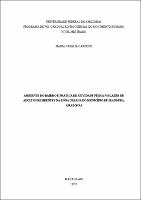| ???jsp.display-item.social.title??? |


|
Please use this identifier to cite or link to this item:
https://tede.ufam.edu.br/handle/tede/11096Full metadata record
| DC Field | Value | Language |
|---|---|---|
| dc.creator | Cardoso, Maria Natália | - |
| dc.creator.Lattes | http://lattes.cnpq.br/0707629497310667 | eng |
| dc.contributor.advisor1 | Leon, Elisa Brosina de | - |
| dc.contributor.advisor1Lattes | http://lattes.cnpq.br/0202938688575304 | eng |
| dc.contributor.advisor-co1 | Rech, Cassiano Ricardo | - |
| dc.contributor.advisor-co1Lattes | http://lattes.cnpq.br/6389536195872970 | eng |
| dc.contributor.referee1 | Hino, Adriano Akira Ferreira | - |
| dc.contributor.referee2 | Autran, Roseanne Gomes | - |
| dc.date.issued | 2025-07-18 | - |
| dc.identifier.citation | CARDOSO, Maria Natália. Ambiente do bairro e prática de atividade física de lazer em adultos residentes da zona urbana do município de Iranduba, Amazonas. 2025. 87 f. Dissertação (Mestrado em Ciências do Movimento Humano) - Universidade Federal do Amazonas, Manaus (AM), 2025. | eng |
| dc.identifier.uri | https://tede.ufam.edu.br/handle/tede/11096 | - |
| dc.description.resumo | Introdução: Os ambientes físico e social podem ser cruciais para a adoção e manutenção de comportamentos saudáveis, como a atividade física no tempo livre. Para compreender a influência dos ambientes na prática de atividade física no tempo livre, é essencial investigar sua distribuição espacial e a qualidade de suas estruturas. Além disso, a distância entre esses locais e os domicílios pode representar um fator limitante importante, reforçando a necessidade de se analisar a acessibilidade. Outro aspecto a ser considerado é a percepção que os indivíduos têm do ambiente onde vivem. Características como segurança, tráfego, condições das calçadas e estímulos visuais exercem influência direta na prática de atividade física no tempo livre. Objetivo: Analisar a relação entre as características do ambiente do bairro e a prática de atividade física no tempo livre em adultos residentes na zona urbana do Município de Iranduba, Amazonas. Metodologia: Estudo do tipo transversal observacional parte de um estudo maior denominado “Intervenção liderada por agentes comunitários de saúde para manejo de Diabetes tipo 2 no interior do Amazonas”. Os dados dessa pesquisa foram coletados no município de Iranduba/Amazonas (38,1 km de carro da capital). Resultados: Entre os 274 participantes, 53,3% moravam dentro de um raio de 500 metros de distância de algum espaço para prática de atividade física no tempo livre. Os resultados não apresentaram associação entre a prática de atividade física no tempo livre e a presença, quantidade ou qualidade dos espaços públicos/comunitários. Todavia houve associação entre a percepção do ambiente do bairro com a prática de atividade física no tempo livre, os resultados seguem uma ordem crescente podendo indicar uma associação linear entre a percepção do ambiente e a motivação para realizar atividade física no tempo livre, onde quanto maior a qualidade percebida do ambiente maior o envolvimento dessas pessoas com a atividade física no tempo livre. Demonstrando que as pessoas que caminham dez ou mais minutos por semana e percebe a qualidade do ambiente como média tem 2,44 (1,01-5,88) vezes mais chances de realizar atividade física no tempo livre, esse número aumenta para 3,00 (1,22-7,33) no terceiro tercil com a qualidade do ambiente percebida como alta. Conclusão: A presença física de EPCs de lazer não se mostrou, por si só, um fator motivador, mas identificou-se uma associação positiva entre a percepção subjetiva da qualidade ambiental e a prática de atividade física no tempo livre, indicando que indivíduos que consideram o ambiente mais favorável tendem a ser mais ativos. | eng |
| dc.description.abstract | Introduction: The physical and social environments can be crucial for the adoption and maintenance of healthy behaviors, such as leisure-time physical activity. To understand the influence of environments on leisure-time physical activity, it is essential to investigate their spatial distribution and the quality of their structures. Furthermore, the distance between these locations and homes can represent a significant limiting factor, reinforcing the need to analyze accessibility. Another aspect to be considered is individuals' perception of the environment in which they live. Characteristics such as safety, traffic, sidewalk conditions, and visual stimuli directly influence leisure-time physical activity. Objective: To analyze the relationship between neighborhood environmental characteristics and leisure-time physical activity among adults living in the urban area of the municipality of Iranduba, Amazonas. Methodology: This observational, cross-sectional study is part of a larger study entitled "Intervention led by community health agents for the management of type 2 diabetes in the interior of Amazonas." Data for this research were collected in the municipality of Iranduba, Amazonas (38.1 km by car from the capital). Results: Among the 274 participants, 53.3% lived within a 500-meter radius of some space for leisure-time physical activity. The results showed no association between leisure-time physical activity and the presence, quantity, or quality of public/community spaces. However, there was an association between the perception of the neighborhood environment and leisure-time physical activity. The results follow an ascending order, possibly indicating a linear association between environmental perception and motivation to engage in leisure-time physical activity. The higher the perceived quality of the environment, the greater the engagement of these individuals in leisure-time physical activity. Demonstrating that people who walk ten or more minutes per week and perceive the quality of the environment as average are 2.44 (1.01-5.88) times more likely to engage in leisure-time physical activity, this number increases to 3.00 (1.22-7.33) in the third tertile with high perceived environmental quality. Conclusion: The physical presence of leisure-time EPCs did not, by itself, prove to be a motivating factor, but a positive association was identified between the subjective perception of environmental quality and the practice of physical activity in leisure time, indicating that individuals who consider the environment more favorable tend to be more active. | eng |
| dc.description.sponsorship | CAPES - Coordenação de Aperfeiçoamento de Pessoal de Nível Superior | eng |
| dc.description.sponsorship | FAPEAM - Fundação de Amparo à Pesquisa do Estado do Amazonas | eng |
| dc.format | application/pdf | * |
| dc.thumbnail.url | https://tede.ufam.edu.br/retrieve/86894/DISS_MariaNataliaCardoso_PPGCiMH.jpg | * |
| dc.language | por | eng |
| dc.publisher | Universidade Federal do Amazonas | eng |
| dc.publisher.department | Faculdade de Educação Física e Fisioterapia | eng |
| dc.publisher.country | Brasil | eng |
| dc.publisher.initials | UFAM | eng |
| dc.publisher.program | Programa de Pós Graduação em Ciências do Movimento Humano | eng |
| dc.rights | Acesso Aberto | - |
| dc.rights.uri | https://creativecommons.org/licenses/by-nc-nd/4.0/ | pt_BR |
| dc.subject | Cuidados primários de saúde | por |
| dc.subject | Diabetes | por |
| dc.subject.cnpq | CIENCIAS DA SAUDE: EDUCACAO FISICA | eng |
| dc.subject.cnpq | CIENCIAS DA SAUDE: SAUDE COLETIVA: SAUDE PUBLICA | eng |
| dc.title | Ambiente do bairro e prática de atividade física de lazer em adultos residentes da zona urbana do município de Iranduba, Amazonas | eng |
| dc.title.alternative | Neighborhood environment and leisure-time physical activity practice among adults residents in the urban area of Iranduba, Amazonas | eng |
| dc.type | Dissertação | eng |
| dc.subject.user | Diabetes Mellitus | por |
| dc.subject.user | Atividade Física | por |
| dc.subject.user | Percepção do ambiente | por |
| dc.subject.user | Ambiente construído | por |
| Appears in Collections: | Mestrado em Ciências do Movimento Humano | |
Files in This Item:
| File | Description | Size | Format | |
|---|---|---|---|---|
| DISS_MariaNataliaCardoso_PPGCiMH | 1.77 MB | Adobe PDF |  Download/Open Preview |
Items in DSpace are protected by copyright, with all rights reserved, unless otherwise indicated.




